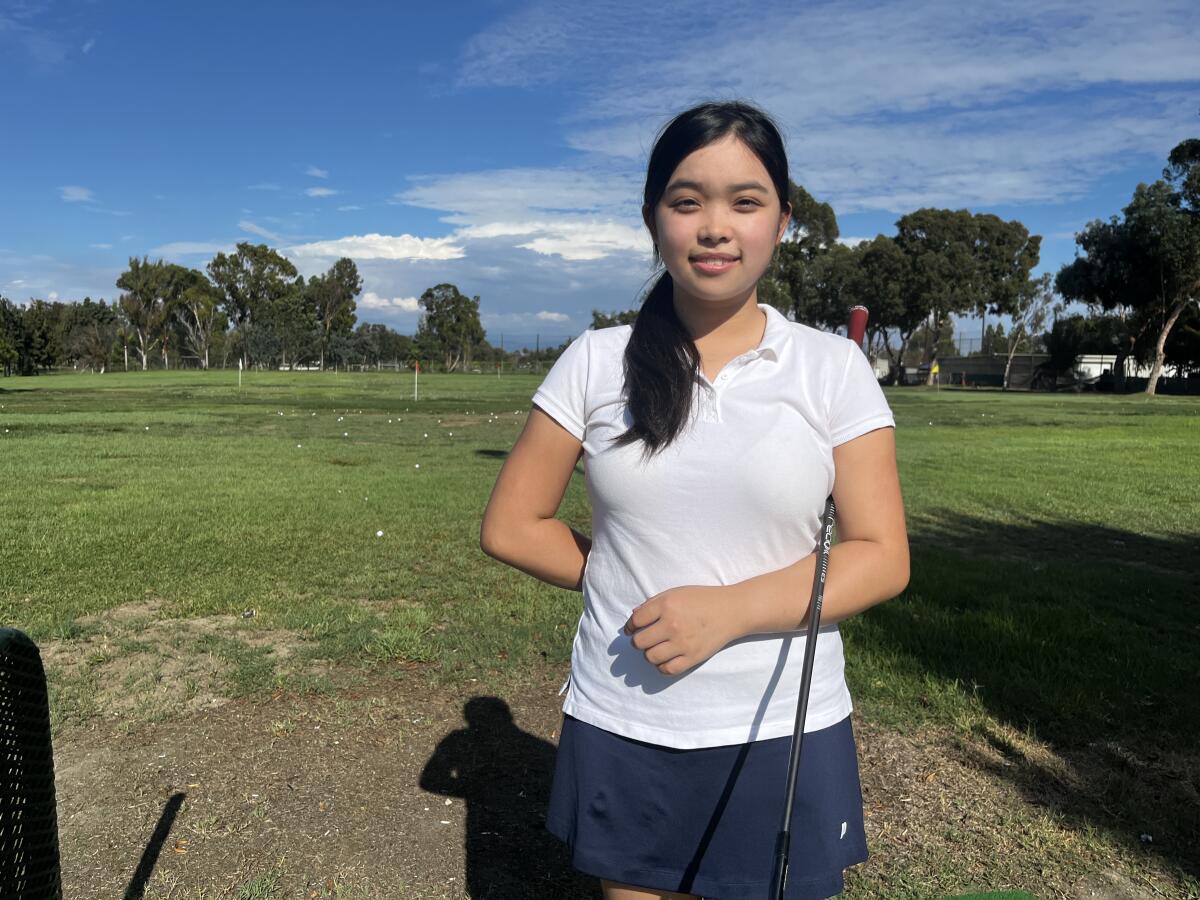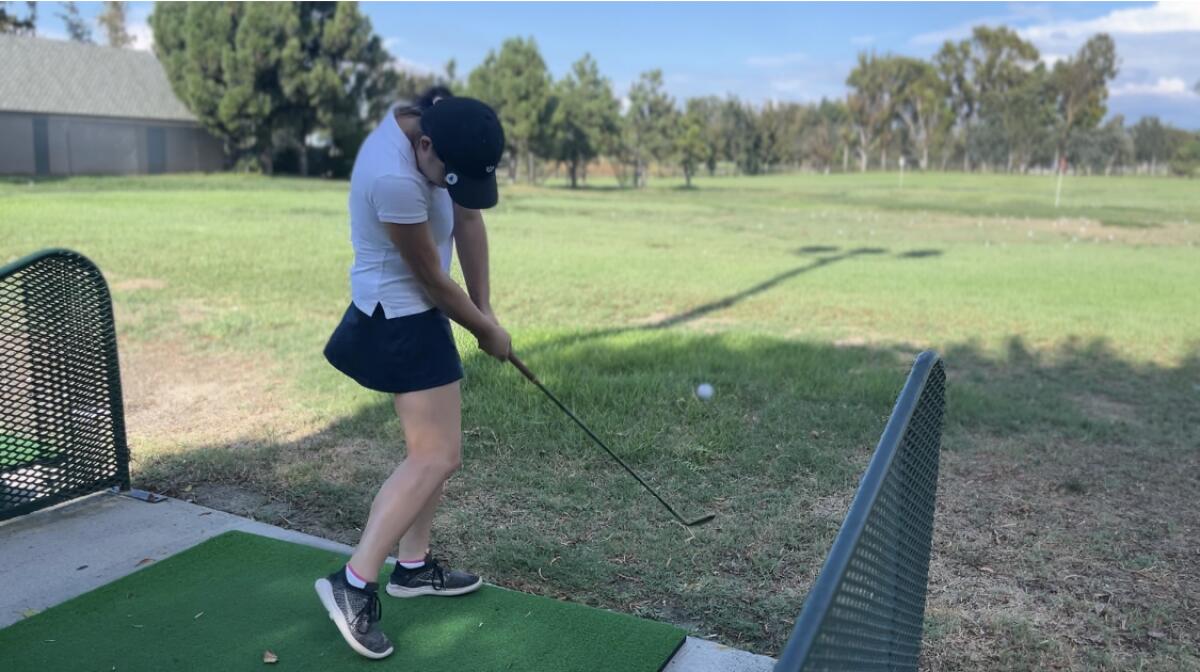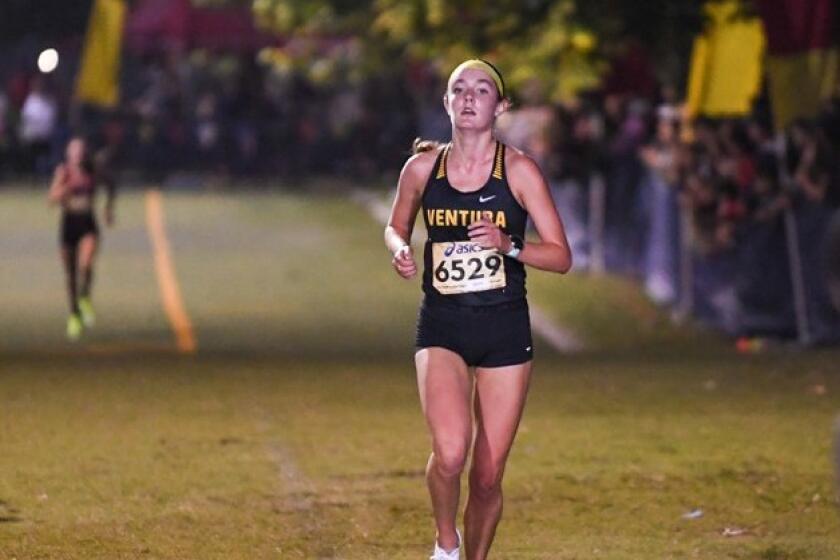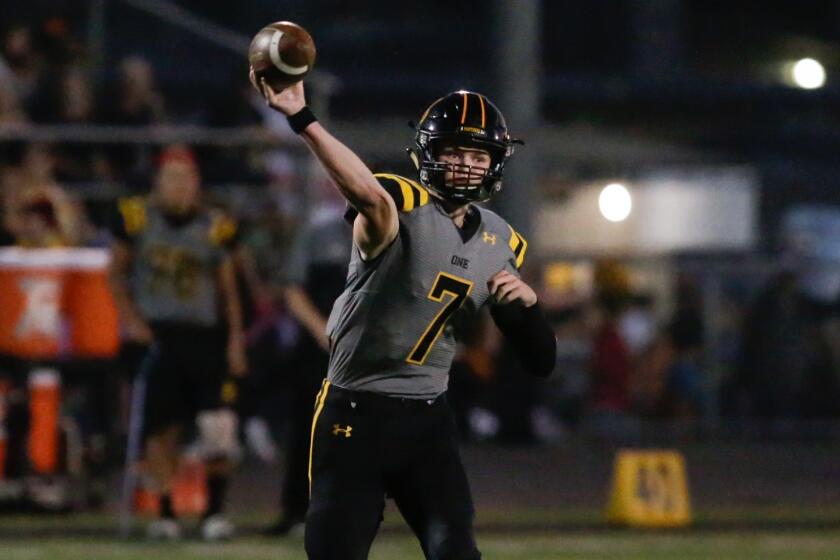After a stroke nearly killed her at 14, Dakota Lam perseveres in life and golf

- Share via
At 16 years old, she’s losing her fingernails.
The layers are flaking away, a side effect of her medication. It’s hard for Fountain Valley High junior Dakota Lam to grip a pencil, let alone a golf club. Her fingers pulse after enough swings, and then the blood comes, spurting from the raw skin underneath the nails.
It always scares her father, Nghia. He takes his daughter home after practice to soak her hands in saltwater, hands he held as she lay in her hospital bed two years ago, clinging to life after a stroke. Bleeding triggers memories of the mysterious condition that sunk her platelet levels.
What if it comes back?
“Nobody knows, really,” Nghia Lam said. “It’s in God’s hands, almost.”
Ventura sophomore Sadie Engelhardt runs 15:42.6 at Woodbridge Classic, which was a meet record.
Few understand, really, what Dakota has gone through: memory loss, speech deficiency, headaches that feel like needles stabbing her brain. But she shrugs it off, hiding it all behind a happy-to-be-here smile.
Golf can bring Lam pain, but it’s also her happy place, a present free of worry over an uncertain future. Gripes, complaints, negativity she feels won’t change her situation.
“I try to be as optimistic as I can about it,” Lam said. “Try to make the best of what I have.”
Nghia, an engineer and former golfer, figured if he got his daughter hooked on golf, she’d spend more time with him.
So ever since she was 7, they’d go to the range for a couple hours every day after school, Lam growing to love the sport.
She never played in amateur competitions while honing a swing that could drive a ball more than 200 yards since she was young. Lam was excited to join the team at Fountain Valley, a solid program that finished a shot shy of winning a league title last year.
“She just has a very long, fluid golf swing,” Fountain Valley coach Carter Keyser said.
But in August 2020, before her freshman year, Lam noticed spots popping up on her skin, called petechiae. Doctors determined her platelet levels, cells that help blood clot, were notably low. Various remedies didn’t work, and Lam went into the hospital for a week in late September, fatigued to the point she barely could put on her pants.
“I told her, ‘In life, you’re going to fall down many times — it’s how you get up. ‘Just … don’t die.”
— Nghia Lam, Dakota’s father
After her blood pressure suddenly went haywire, a scan revealed she had an amount of blood in her brain the size of “four golf balls,” Nghia said.
“She came this close,” her father said, holding his index and thumb fingers millimeters apart.
They don’t talk about the possibility it all could happen again.
That fall, Lam was intubated for four days. As a doctor told her father she’d need to learn how to walk again, she flashed him a thumbs-up.
To Nghia’s shock, she started walking again four days later.
“I told her, ‘In life, you’re going to fall down many times — it’s how you get up,’” Nghia said, pausing.
“‘Just … don’t die,’” he sobbed.
A few months after the stroke, Keyser called up Lam to hit in her first practice at Fountain Valley when blood started gushing out of her nose, her dad remembered, coating her sweater.
“It was kind of a scare for everybody,” Lam said.
But Lam was determined to play. She took off the sweater and continued.
“She doesn’t give up,” her father said. “She’ll keep coming, bleeding or not bleeding.”
School was a challenge — sometimes she’d forget everything she studied the night before, her short-term memory still recovering. But she had dreams to play golf in college and expected the best from herself.
“I felt like I just started back to square one again,” Lam said.
Shortly into her freshman year, Lam suffered a wrist injury trying too hard to compensate for weakness in her right side. After rehab, her first match was “terrible,” she remembered. Practices weren’t much easier. She’d grasp the club and panicked thoughts would set in.
“Everyone has their own disadvantages, and this is mine. Just gotta deal with it, and keep going.”
— Dakota Lam
I need to make a shot. I need to get this chip.
Her hands started shaking, feeling like they’d fall off, she said.
“Sometimes, I worry about her,” teammate Kendyl Thitathan said, “because she’s so hard on herself.”
Through ups and downs, headaches and rest days, Lam worked to get back on the course. Her scores gradually improved and she took a significant step by finishing a shot short of a gold medal with a one-over-par performance against Huntington Beach last year.
“Just to come back out here and play decently, I think, is kind of an accomplishment for me,” Lam said.

In February, after she got her COVID-19 booster, Lam’s symptoms returned.
She spent most of the spring in the hospital, her platelet levels in freefall again. Doctors gave her Rituxan, which is typically used to treat cancer.
“You live day to day,” Nghia said.
She stabilized in June and is in remission. But doctors don’t know whether the problem is truly gone, her father said.
“She thinks she gets over it just like that, you know?” Nghia said. “I don’t want to tell her anything other than that.”
Through four matches this season, she’s averaged the second-lowest nine-hole score on a team that has state championship aspirations.
Freshman quarterback Brady Smigiel puts on show, passing for 245 yards and four touchdowns in Newbury Park’s 55-0 victory over Royal.
“She’s just super consistent … she’s always in the top five, always,” Keyser said.
One day recently, she recounted to her father every shot she hit — an encouraging sign, Nghia said, that she might be healthy enough to play in college. But her journey isn’t over.
While practicing two weeks ago, Thitathan said, Lam was trying to hit out of a bunker and thumped her club against the sand, the vibration triggering pain in her wrist. She winced, and her friend urged her to call for help.
Nope. Lam brushed it off, Thitathan said, and kept playing.
“Everyone has their own disadvantages, and this is mine,” Lam said. “Just gotta deal with it and keep going.”
More to Read
Get our high school sports newsletter
Prep Rally is devoted to the SoCal high school sports experience, bringing you scores, stories and a behind-the-scenes look at what makes prep sports so popular.
You may occasionally receive promotional content from the Los Angeles Times.









